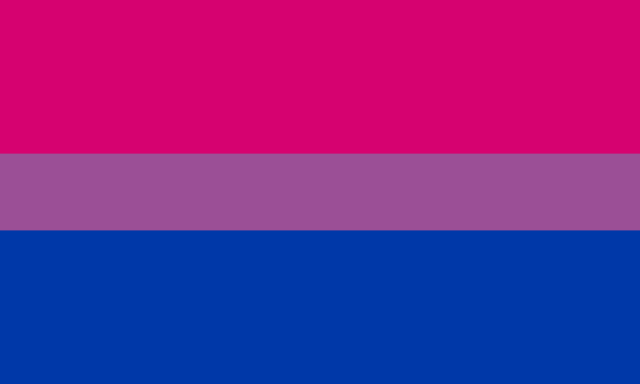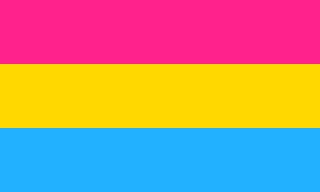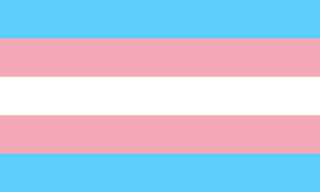Loading AI tools
来自维基百科,自由的百科全书
骄傲旗(英语:Pride flag)是代表LGBTQ的一部分的任何旗帜,“骄傲”一词指的是同志骄傲的概念,这个术语与“同志旗”和“酷儿旗”经常互换使用。[1]

骄傲旗可以代表各种性取向、恋爱倾向、性别认同、酷儿文化、区域及整个LGBTQ社区,有些骄傲旗并非专门与LGBTQ相关,例如:皮革自豪之旗。代表整个LGBTQ社区的彩虹旗,是使用最广泛的其中一种骄傲旗。
许多社区采用不同的旗帜,其中大多数都从彩虹旗中汲取灵感。这些旗帜通常由业余设计师设计,并在网络或附属组织中逐渐受到关注,最终成为社区的象征性代表,取得半官方的地位。通常这些旗帜包含多种颜色,象征着包容相关社区的不同特性。
Gilbert Baker designed the rainbow pride flag for the 1978 San Francisco Gay Freedom Day celebration.[2] The flag was designed as a "symbol of hope" and liberation, and an alternative to the symbolism of the pink triangle.[3] The flag does not depict an actual rainbow. Rather, the colors of the rainbow are displayed as horizontal stripes, with red at the top and violet at the bottom. It represents the diversity of gays and lesbians around the world. In the original eight-color version, pink stood for sexuality, red for life, orange for healing, yellow for the sun, green for nature, turquoise for art, indigo for harmony, and violet for spirit.[4] A copy of the original 20-by-30 foot, eight-color flag was made by Baker in 2000 and was installed in the Castro district in San Francisco.[5] Many variations on the rainbow flag exist, including ones incorporating other LGBTQ symbols like the triangle or lambda.[6] In 2018, designer Daniel Quasar created a modified version of the rainbow pride flag, incorporating elements of other flags to bring focus on inclusion and progress. This flag is known as the Progress Pride Flag. In 2021, Valentino Vecchietti of Intersex Equality Rights UK redesigned the Progress Pride Flag to incorporate the intersex flag.[7][8]

The aromantic pride flag consists of five horizontal stripes, which are (from top to bottom) green, light green, white, gray, and black. The flag was created by Cameron Whimsy[9] in 2014.[10] The green and light green stripes represent aromanticism and the aro-spectrum. The white stripe represents the importance and validity of non-romantic forms of love, which include friendship, platonic and aesthetic attraction, queerplatonic relationships, and family. The black and gray stripes represent the sexuality spectrum, which ranges from aro-aces (aromantic asexuals) to aromantic allosexuals.[9][10]

The asexual pride flag consists of four horizontal stripes: black, gray, white, and purple from top to bottom.[11][12][页码请求] The flag was created by an Asexual Visibility and Education Network user standup in August 2010, as part of a community effort to create and choose a flag.[13][14] The black stripe represents asexuality; the gray stripe represents gray-asexuals and demisexuals; the white stripe represents allies; and the purple stripe represents community.[15][16]

Introduced on December 5, 1998,[17] the bisexual pride flag was designed by activist Michael Page to represent and increase the visibility of bisexual people in the LGBTQ community and society as a whole. Page chose a combination of Pantone Matching System (PMS) colors magenta (pink), lavender (purple), and royal (blue).[17] The finished rectangular flag consists of a broad pink stripe at the top, a broad stripe in blue at the bottom, and a narrow purple stripe in the center.
Page described the meaning of the colors as, "The pink color represents sexual attraction to the same sex only (gay and lesbian), the blue represents sexual attraction to the opposite sex only (straight) and the resultant overlap color purple represents sexual attraction to both sexes (bi)."[17] He also described the flag's meaning in deeper terms, stating "The key to understanding the symbolism in the Bi Pride Flag is to know that the purple pixels of color blend unnoticeably into both the pink and blue, just as in the 'real world' where bi people blend unnoticeably into both the gay/lesbian and straight communities."[17][18]

Page stated that he took the colors and overlap for the flag from the biangles symbol of bisexuality.[19][20] The blue and pink overlapping triangle symbol is the biangles symbol of bisexuality, and was designed by artist Liz Nania as she co-organized a bisexual contingent for the Second National March on Washington for Lesbian and Gay Rights in 1987.[20][21] The design of the biangles began with the pink triangle, a Nazi concentration camp badge that later became a symbol of gay liberation representing homosexuality. The addition of a blue triangle contrasts the pink and represents heterosexuality. The two triangles overlap and form lavender, which represents the "queerness of bisexuality", referencing the Lavender Menace and 1980s and 1990s associations of lavender with queerness.[22]
Various pride flags have been used to symbolize gay men. Rainbow flags have been used since 1978 to represent both gay men and, subsequently, the LGBTQ community as a whole. Since the 2010s, various designs have been proposed to specifically represent the gay male community.

The intersex flag was created by Morgan Carpenter of Intersex Human Rights Australia in July 2013 to create a flag "that is not derivative, but is yet firmly grounded in meaning". The organization describes the circle as "unbroken and unornamented, symbolising wholeness and completeness, and our potentialities. We are still fighting for bodily autonomy and genital integrity, and this symbolises the right to be who and how we want to be".[23][24][25]
No single design for a lesbian-pride flag has been widely adopted.[26] However, many popular ones exist.
The labrys lesbian flag was created in 1999 by graphic designer Sean Campbell, and published in June 2000 in the Palm Springs edition of the Gay and Lesbian Times Pride issue.[26][27] The design involves a labrys, a type of double-headed axe, superimposed on the inverted black triangle, set against a violet background. Among its functions, the labrys was associated as a weapon used by the Amazons of mythology.[28][29] In the 1970s it was adopted as a symbol of empowerment by the lesbian feminist community.[30] Women considered asocial by Nazi Germany for not conforming to the Nazi ideal of a woman, which included homosexual females, were condemned to concentration camps[31] and wore an inverted black triangle badge to identify them.[32] Some lesbians reclaimed this symbol as gay men reclaimed the pink triangle (many lesbians also reclaimed the pink triangle although lesbians were not included in Paragraph 175 of the German criminal code).[32] The color violet became associated with lesbians via the poetry of Sappho.[33]
The lipstick lesbian flag was introduced by Natalie McCray in 2010 in the weblog This Lesbian Life.[34][35] The design contains a red kiss in the left corner, superimposed on seven stripes consisting of six shades of red and pink colors and a white bar in the center.[36][37] The lipstick lesbian flag represents "homosexual women who have a more feminine gender expression", but has not been widely adopted.[26] Some lesbians are against it because it does not include butch lesbians, while others have accused McCray of writing biphobic, racist, and transphobic comments on her blog.[38]
The "pink" lesbian flag was derived from the lipstick lesbian flag but with the kiss mark removed.[37] The pink flag attracted more use as a general lesbian pride flag.[39]
The "orange-pink" lesbian flag, modeled after the seven-band pink flag, was introduced on Tumblr by blogger Emily Gwen in 2018.[40][41] The colors include dark orange for "gender non-conformity", orange for "independence", light orange for "community", white for "unique relationships to womanhood", pink for "serenity and peace", dusty pink for "love and sex", and dark rose for "femininity".[41] A five-stripes version was soon derived from the 2018 colors.[42]

The non-binary pride flag was created in 2014 by Kye Rowan.[44] Each stripe color represents different types of non-binary identities: yellow for people who identify outside of the gender binary, white for non-binary people with multiple genders, purple for those with a mixture of both male and female genders, and black for agender individuals.[45]

The pansexual pride flag was introduced in October 2010 in a Tumblr blog ("Pansexual Pride Flag").[46][47] It has three horizontal bars that are pink, yellow and blue.[46][48][49][来源可靠?] "The pink represents being attracted to women, the blue being attracted to men, and the yellow for being attracted to everyone else";[46] such as non-binary gender identities.[49][15][50][51]

The transgender pride flag was designed by transgender woman Monica Helms in 1999.[52] It was first publicly displayed at a pride parade in Phoenix, Arizona, US, in 2000.[53] It was flown from a large public flagpole in San Francisco's Castro District beginning November 19, 2012, in commemoration of the Transgender Day of Remembrance.[53] The flag represents the transgender community and consists of five horizontal stripes: two light blue, two pink, with a white stripe in the center. Helms described the meaning of the flag as follows:[54]
The stripes at the top and bottom are light blue, the traditional color for baby boys. The stripes next to them are pink, the traditional color for baby girls.[53] The white stripe is for people that are nonbinary, feel that they don't have a gender.[55][56] The pattern is such that no matter which way you fly it, it is always correct, signifying us finding correctness in our lives.[53]
Philadelphia became the first county government in the United States to raise the transgender pride flag in 2015. It was raised at City Hall in honor of Philadelphia's 14th Annual Trans Health Conference, and remained next to the US and City of Philadelphia flags for the entirety of the conference. Then-Mayor Michael Nutter gave a speech in honor of the trans community's acceptance in Philadelphia.[57]
Seamless Wikipedia browsing. On steroids.
Every time you click a link to Wikipedia, Wiktionary or Wikiquote in your browser's search results, it will show the modern Wikiwand interface.
Wikiwand extension is a five stars, simple, with minimum permission required to keep your browsing private, safe and transparent.